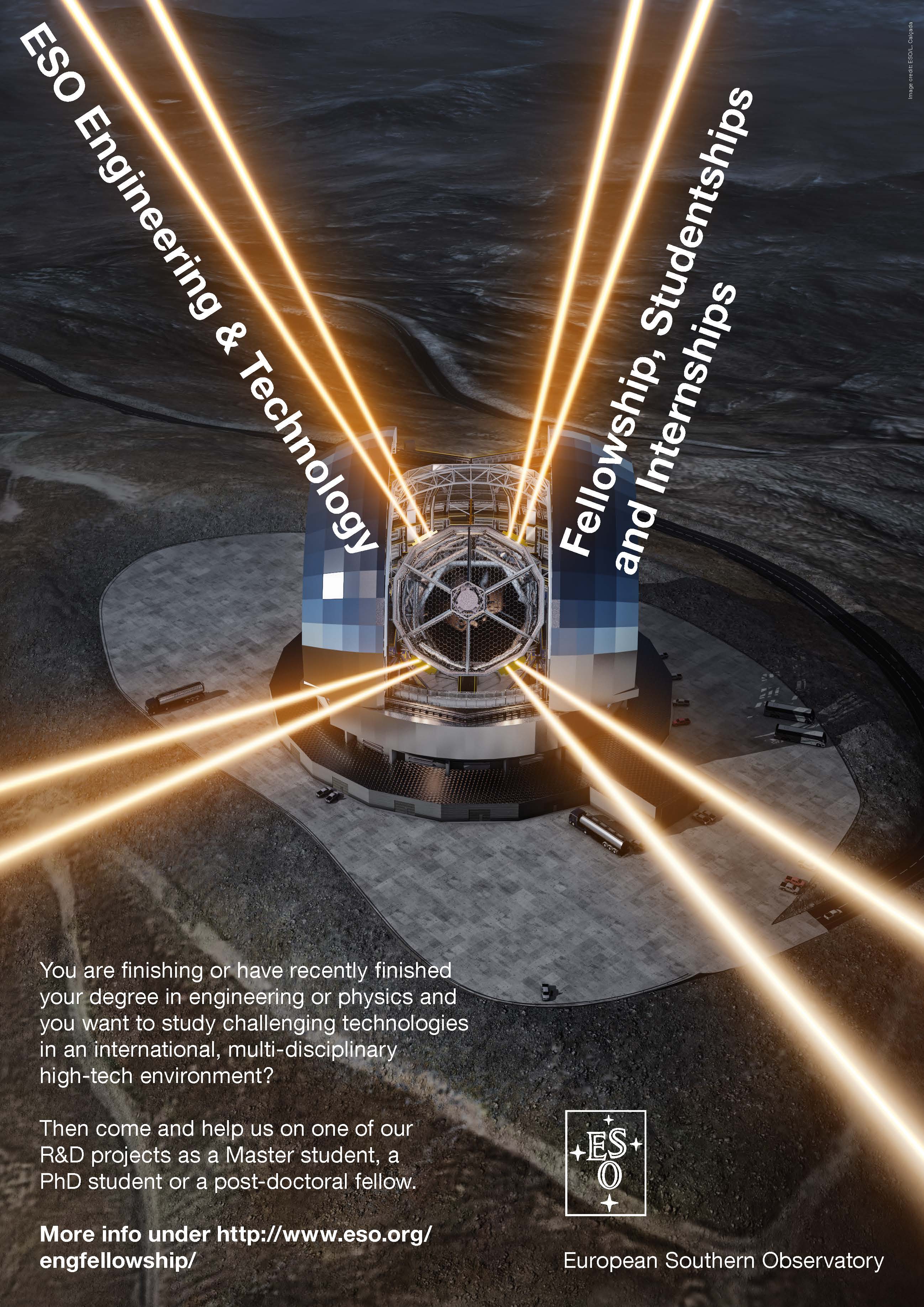ESO Engineering and Technology Research Fellowships / Studentships / Internships
 |
What are we looking for?
Dynamic young individuals ready to take an active part in the ESO R&D projects with a good deal of team spirit, curiosity and eagerness to learn.
New opportunities should open in 2025.
|
 |
What do we offer?
 |
|
What kind of R&D is being done at ESO?
ESO is working on developments in many fields of engineering. Here are some examples of past and current research & development topics:
- Advanced visible and infra-red detectors: development of new e-APD arrays and CMOS detectors in collaboration with the industry, modeling and advanced testing of the detectors, characterization and optimization, controller development…
- Sub-millimeter receivers for ALMA (Atacama Large Millimeter Array): development of cryogenic first-stage amplifiers, development of band 2+3 cartridges…
- Adaptive optics: extreme adaptive optics testbench for exo-planet observation; development of new technologies for deformable mirrors in collaboration with the industry; advanced, extensive AO simulation tools; study and development of new wavefront sensor concepts …
- Laser guide stars: solid state laser development in collaboration with the industry; testing of the laser guide star return flux; up-link and down-link tip-tilt correction for laser communications in collaboration with ESA; field experiments at la Palma (Canary Islands) …
- Interferometry: fringe tracking; differential astrometry; data reduction for high angular resolution imaging …
- Optics and photonics technologies: deflectometry feasibility studies; active phasing experiment; optical metrologies for the characterization at sub-micron level of large scale structures … in our 900 m2 of optical laboratories and integration halls
- Mechanical engineering: opto-mechanics and cryogeny for astronomical instrumentation and telescopes, finite-element analysis and modeling of large structures including wind, gravity and temperature effects, vibration analysis and fighting…
- Control software & engineering: PLC controllers for instruments and cryostats, Real Time Computing Systems for adaptive optics and for the ELT …
- Systems engineering: Prototyping a model-based system engineering (MBSE) approach; verification and commissioning of complex systems; reliability & availability analysis for an VLT or ELT instrument…
- Design of electronic boards: schematics, layout, manufacturing and test
Interested?
If you are interested in enhancing your early career through an ESO Fellowship, Studentship or Master thesis, then please apply by completing the web application form available at
http://jobs.eso.org
What could you be working on?
The candidates for an internship in their last year of studies can choose one (or a couple) of the subjects proposed in this page, according to their studies, experience and interests.
It is expected from the PhD studentship candidates that they develop and grow their research plan based on one of our original subjects given in this page in discussion with their supervisor in their home university and with the ESO supervisor. Sorry, currently all student positions are filled. New opportunities will open in 2025.
Fellowship candidates have to come with their own original, personal research plan and therefore we do not propose specific subjects. Of course candidates are free to take inspiration from the various research topics described here, as we have the infrastructure necessary to support them. But the personal research plan has to show the own ideas, imagination, initiative and structured approach of the candidates.
How to apply
Please go to the ESO recruitment portal https://recruitment.eso.org.
If positions are available you will find a line with “Engineering Internship” / “Engineering Studentship” / “Engineering Fellowship” respectively. Click on the appropriate link, depending on the type of position you would like to apply to, and follow the instructions.
For an internship, the documents to attach to your application are just:
- a cover letter including which project(s) are interesting you and why;
- a curriculum vitae with an outline of your technical/practical experience and a list of publications, if any.
For the internships, the vacancy is open-ended until the 4 positions for 2024 have been filled. The internships are expected to start any time in 2024.
For a PhD studentship, you have to provide:
- a cover letter including which PhD subject you would like to work on and why;
- a curriculum vitae with an outline of your technical/practical experience and a list of publications, if any;
- the names and contact details of three persons familiar with your research and/or engineering work and willing to provide a recommendation letter
- an outline of how you plan to develop the PhD project (maximum of two pages), with a timeline, the requested starting date and duration,
- A letter from the formal supervisor at your home institute agreeing with the project plan and (if the studentship is requested for less than 3 years) guaranteeing financial support (salary, health insurance, travel money) for the part of the PhD done at the home institute.
Please note that if you are the chosen candidate, you will need to provide, before starting the PhD, a letter from your home institute indicating that the pre-requisites to obtain a PhD degree at the home institute have been met.
As mentioned above, currently all PhD positions are filled. New opportunities should open in 2025.
For a fellowship, you have to include in your application:
- a cover letter including why you want to do a post-doctorate at ESO;
- a curriculum vitae with an outline of your technical/practical experience and a list of publications;
- the names and contact details of three persons familiar with your research and/or engineering work and willing to provide a recommendation letter
- a description of your original research project (maximum of three pages), with a work plan, a timeline, the requested starting date and duration.
